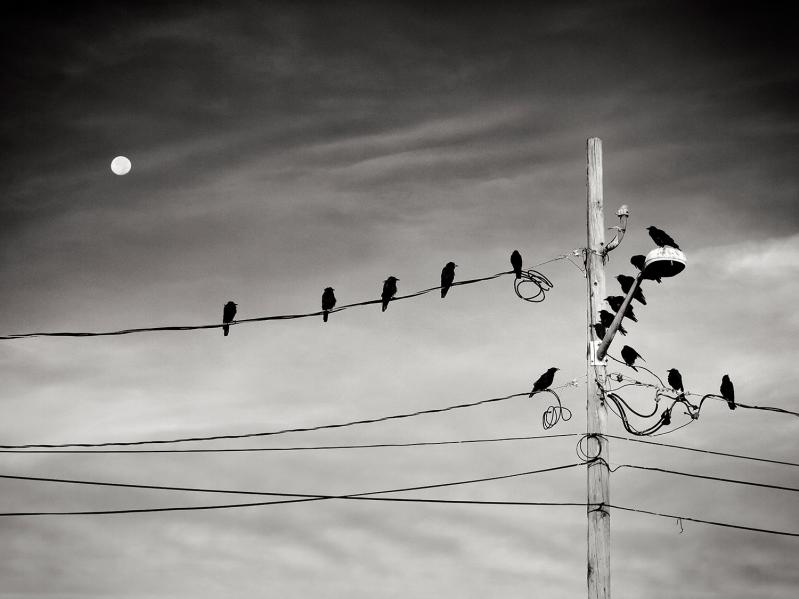First light in Sag Harbor during autumn and the place belongs to the fish crows. They show up all at once, 100 landing in the big tree at M&T bank. As the day brightens, they spread out across the village into smaller groups.
They coast low down empty Main Street and over the sidewalks. Two land on a bench, observing a walker before hopping off in search of sidewalk scraps. One discovers a hunk of roll discarded by an early morning Sagtown Coffee customer. A chase begins.
They call from the trees that line Main Street, hidden by the browning leaves, and watch from electrical wires, black with the white sky above. Wing to wing they stand on the edge of the roof at Bay Street Theater. Long before the village was full of security cameras, these birds were watching.
Fish crows are nearly identical to the American crow but they’re slightly smaller. In “Birds of New York State,” written by John Bull, he said, “Few species are more misidentified by the beginner.”
The call is their most identifiable field mark and luckily, they’re not quiet.
They are most noticeable at the be ginning of cold season, which is appropriate because the guides say a fish crow sounds like an American crow with a cold. The “CAW!” of the American crow is readily recognized. The quality of the fish crow’s call is softer, mellower. I mostly hear them say, “Ah uh!” but sometimes, they shorten it to a simple “Uh!” More than other birds, they seem to be “talking” to each other, enjoying early morning conversations across the street.
Listening to them is not unpleasant. Or maybe I’m just happy to be in the village before other people wake up.
Why are they here? They’ve been around all summer, breeding. The difference is that during the breeding season, they spread out. Jean Held had a pair nest in a white pine across from her Franklin Avenue house. She said they’d bring food to her birdbath, to dunk. They build a new nest each year, roughly in the same area as the last.
“May through August they’re on their territories, scattered across the landscape and they mostly don’t hang out together,” said Kevin McGowan, an ornithologist at the Cornell Lab of Ornithology. After Labor Day, our local breeders group together and are joined by others flying south from points north. As their flock grows during early autumn, we notice them more.
A group of about 120 flew north over East Hampton High School at 4:45 on Monday, no doubt to roost up somewhere with the Sag Harbor flock, perhaps in the Long Pond Greenbelt. Bruce Horwith, owner of “Wild Bird Crossing” in the Bridgehampton Commons, says a large group hangs out there as well.
Mr. McGowan said it’s “very likely that the crows break up [from a central roost] and spread out to forage during the day.”
“They stay in big flocks through the winter, congregating at good foraging areas. They don’t migrate exactly, but they do make seasonal movements,” said Mr. McGowan. Our fish crows largely depart sometime by the middle of November. It’s unclear where they go, but probably not too far. Mr. McGowan said coastal New Jersey is a possibility. A handful can be found here year round.
For a bird whose diet ranges from piping plover eggs to candy bars, Sag Harbor is a perfect foraging ground. One hundred years ago, T. Gilbert Pearson, in “Birds of America” wrote, “It feeds largely on such forms of animal life as die and float ashore. It is also a great egg-eater.” They’re adaptable. Driving over the bridge yesterday, I saw two at Steinbeck Park, picking at an empty Buddhaberry cup. Fro-yo wasn’t a thing in Mr. Pearson’s day.
During the breeding season, “the male does most of the hunting while the female attends the nest,” said Mr. McGowan. They raid the nesting colonies of other birds, like herons, least terns, and even songbirds. They’re not exactly like the thieves at Balenciaga, doing smash and grab stuff as a group. “They take advantage of what other birds do; they may be cooperative, but they’re not coordinating,” said Mr. McGowan.
Perhaps their adaptability is why they’re one of the rare birds that has increased in the last 50 years. “The last third of the 20th century they really expanded their range,” said Mr. McGowan. “They now breed as far north as Maine.” They’ve also followed the Mississippi River north and are breeding up to Ohio and Illinois, pushing farther inland from the coasts.
“Crows are very smart,” he said. They cache food, and a cross-world cousin of the fish crow, the New Caledonian crow, has been observed using tools. “They’re like feathered apes. They have the same cognitive ability as a monkey depending on the task,” said Mr. McGowan. “They observe, learn new situations, and take advantage of new opportunities.”
“Between a kindergartner and a fish crow, I’m putting my money on the fish crow,” he said.
It’s nice to say a bird is doing well, even if that bird is all black and might eat a small piece of you, given the opportunity.
The poet Mary Oliver addressed their omnipresence in “Crows,” though she didn’t say which species of crow she was celebrating, exactly. Here’s an excerpt:
Drive down any road,
take a train or an airplane
across the world, leave
your old life behind,
die and be born again —
wherever you arrive
they’ll be there first,
glossy and rowdy
and indistinguishable.
The deep muscle of the world.

